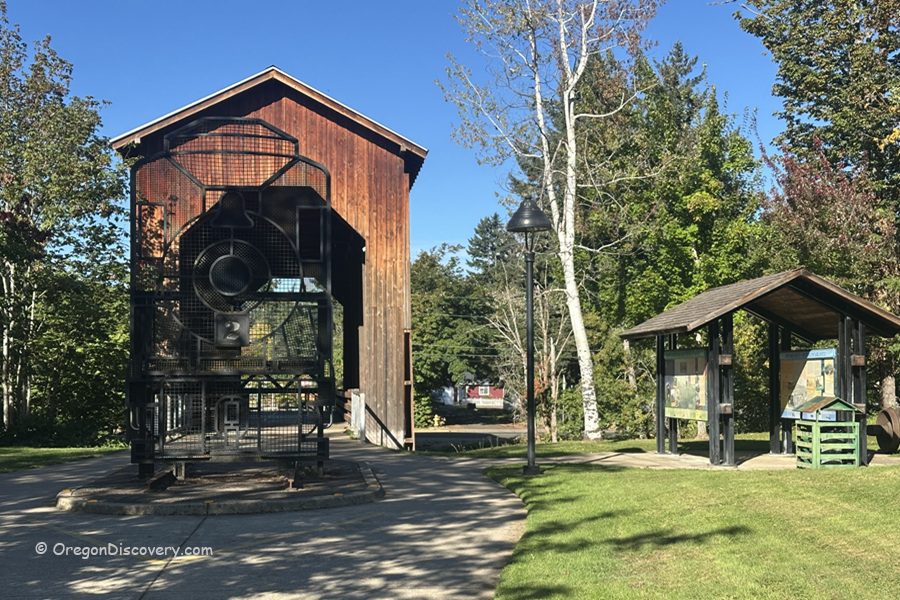
• Chambers Covered Railroad Bridge is the only fully covered railroad bridge West of the Mississippi River
The Chambers Covered Railroad Bridge spans the Coast Fork Willamette River in Cottage Grove, just south of downtown and only a short drive from I-5. This bright white landmark is one of the few surviving historic covered bridges in Oregon from the state’s logging rail era.
Built in 1925, the 78-foot (24 m) Howe truss once carried trains hauling logs from the Lorane Valley to the J.H. Chambers Mill. Restored in 2011, it now welcomes pedestrians who can walk through its tall timber frame and experience a living piece of Cottage Grove’s rail history.
Light filters through the side openings, painting warm lines across the beams. You hear the river murmuring below and the soft echo of your steps. It’s a calm blend of wood, water, and memory that lingers long after you leave. On a hot summer day, the riverbanks nearby offer a refreshing place to cool off.
To explore more of the area, follow the Cottage Grove Covered Bridge Tour or stroll the riverside paths in the Riverwalk district. It’s an easy and rewarding stop on any Willamette Valley road trip between Eugene and Roseburg.
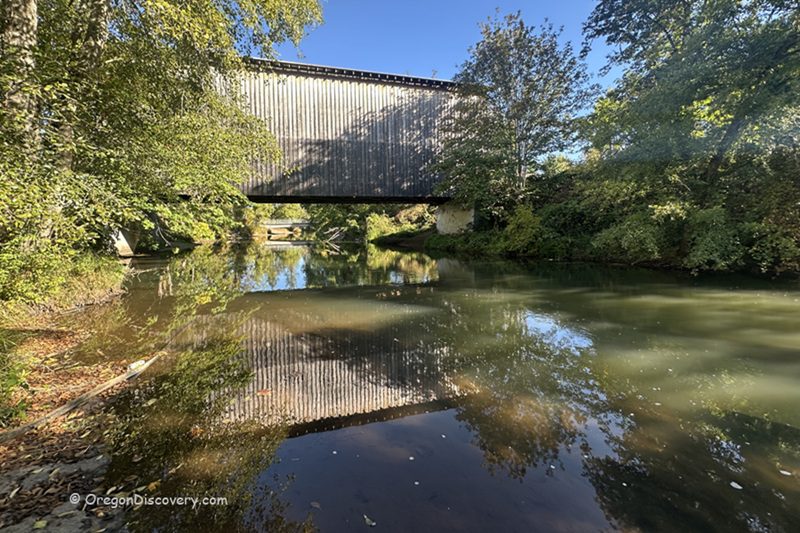
Chambers Covered Railroad Bridge History
If you love Oregon’s covered bridges, the Chambers Covered Railroad Bridge is a must-see. It’s the only fully covered railroad bridge still standing west of the Mississippi River. When I first walked through it, the structure felt sturdy and purposeful—built for work, then rebuilt for people.
The bridge opened in 1925 to serve the J.H. Chambers Mill, carrying heavy log trains between South Highway 99 and the river. The last train crossed in 1951. After the mill burned and closed in the 1950s, the tracks were removed, but the bridge remained.
Decades of weather took their toll. By 2000, the bridge was leaning, and a powerful windstorm in January 2010 pushed it to the brink of collapse. Engineers warned of a potential collapse, and the city of Cottage Grove responded quickly to save it.
Crews carefully disassembled the bridge from the top down. A support platform was slid in from downstream to stabilize the span. Many original parts—like timber chords, decking, and corbels—were too deteriorated to reuse, but as many as possible were restored and reinstalled. A $1.3 million grant from the National Historic Covered Bridge Preservation Program in 2008 helped fund the project.
Rebuilt to match its original design, the Chambers Covered Railroad Bridge reopened in 2011 for pedestrians, standing once again as a proud link to Cottage Grove’s logging past.
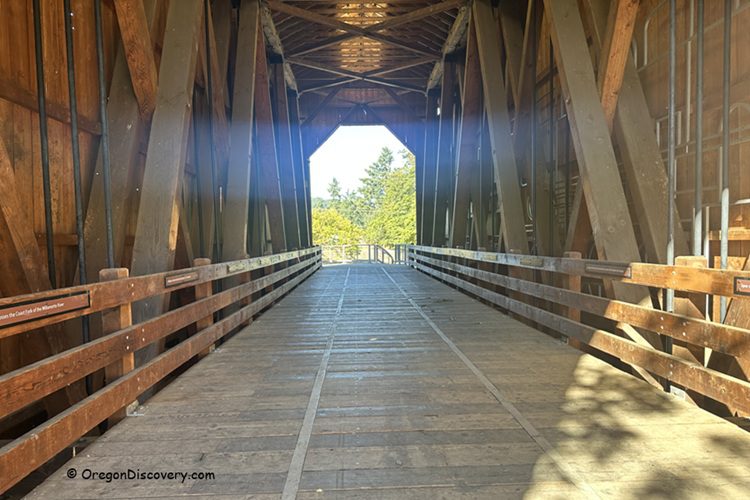
Why is this bridge so special?
Historic Significance: Built in 1925 for logging trains to the J.H. Chambers Mill; last train in 1951; rescued and reconstructed in 2010.
Unique Design: Classic Howe truss with tall portals and stout members sized for steam engines and heavy lumber loads.
Survivor: The only remaining fully covered railroad bridge in the western states, and one of only eight covered railroad bridges left in the United States.
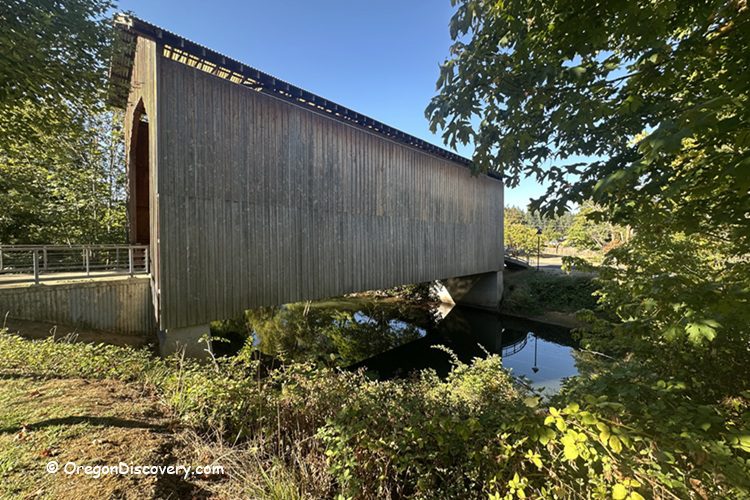
Oregon’s Last Fully Covered Railroad Bridge
Cottage Grove calls itself the Covered Bridge Capital of the West, and this bridge is its bold showpiece. In the late 1800s and early 1900s, logging railroads laced the local mountains.
Massive timber bridges were common - tall for steam engines and extra‑stout for heavy trains. As logging slowed and modern bridge tech arrived, the old covered spans vanished. Chambers Covered Railroad Bridge remains, tying the town to its mill days.
Local memories bring it to life. Every day at 5 p.m., engines blew whistles on the bridge, telling kids it was time to head home. When trains idled, cars stretched through the portal, and bold kids crawled between them to cross (don’t try that now).
On hot Willamette Valley afternoons, deep pools below pulled swimmers in. Some say they learned to swim by getting tossed off the bridge. Times were different, but the stories still flow.
Chambers Covered Railroad Bridge | Facts
Architectural Bridge Design: Howe truss
Bridge access: Pedestrian only
Stream: Coast Fork Willamette River
Bridge Length: 78 ft (24 m)
Built: 1925 (railroad use)
Open: Year-round
Elevation: 700 ft (213 m)
Chambers Covered Railroad Bridge is located:
- 2 miles south of Downtown Cottage Grove
- 21 miles south of Eugene
- 124 miles south of Portland.
Adventures Nearby
Directions to Chambers Covered Railroad Bridge
From I‑5,
- Take exit 174 in Cottage Grove and keep right
- Merge into Cottage Grove Connector and follow it for 0.4 miles
- Bear left onto OR-99 and continue 1.3 miles to Harrison Avenue
- Turn right onto Harrison Avenue, then after two blocks, turn left onto 1st Street and right onto Tyler Avenue.




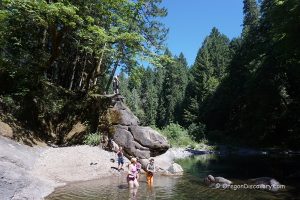
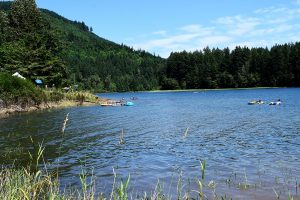
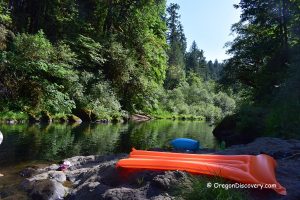
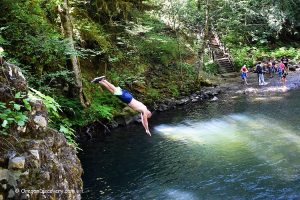
 Broken Bowl Swimming
Broken Bowl Swimming